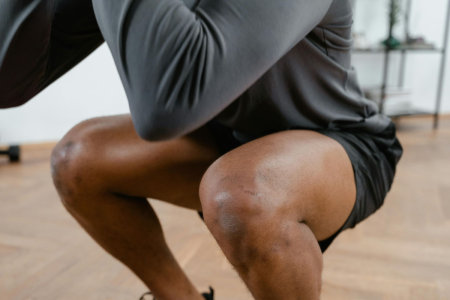Over 50? The secret to stronger knees starts here!
By
Aubrey Razon
- Replies 0
Disclaimer: The information provided in this article is for educational purposes only and is not intended as a substitute for professional medical advice, diagnosis, or treatment. Always consult your physician or other qualified healthcare providers with any questions you may have regarding a medical condition or before making any changes to your health regimen.
Aging brings changes that can quietly challenge our health and mobility. Staying active is the key to staying independent and thriving.
Discover one simple move that could transform how you age—starting today!
The Centers for Disease Control and Prevention (CDC) reports that one in four adults over 65 experiences a fall each year, with potentially serious consequences.
But fear not, dear readers of The GrayVine, because incorporating simple exercises into our daily routine can significantly reduce this risk and keep us thriving.
Enter the weighted high knee exercise, a powerhouse move that's about to become your new best friend.
Dr. Michael Masi, a physical therapist and strength coach, champions this exercise for its multitude of benefits.
Not only does it get your heart pumping, enhancing cardiovascular endurance and strengthening the heart, but it also builds muscle strength and improves balance – two critical factors in preventing falls.
Imagine this: by simply raising your knees, you're engaging your core and the stabilizing muscles in your feet and legs.
This not only helps you stand firmer on the ground but also contributes to your overall muscular health.
And when you add weights to the mix, you're upping the ante, increasing bone mineral density and maintaining muscle mass, which naturally declines with age.
Starting in our 30s, we begin to lose muscle mass, and this process accelerates as we grow older.
This can make everyday activities more challenging and increase the risk of falls.
However, Masi reassures us that it's never too late to start an exercise program.
In fact, transitioning from a sedentary lifestyle to engaging in just 3 hours of exercise each week could slash your all-cause mortality risk by up to 50%.
A 2018 meta-analysis in JAMA Internal Medicine, which pooled results from over 21,000 participants, found that exercising for at least a year can lower your fall risk by 12% and reduce injury risk by 26%.
Strength training, in particular, offers additional perks, such as boosting your metabolism and aiding in healthy weight management.
Ready to give it a try? Here's how to perform the weighted high knee exercise:
1. Start without weights to get comfortable with the movement. Stand with your feet hip-width apart and feel both feet firmly planted on the ground.
2. Shift your weight to your left foot, using your leg muscles to stabilize as you bend your right knee.
3. If you're unsteady, use a hand for support against a countertop or wall.
4. Lift your right thigh until it's parallel to the floor, engaging your left leg and hip muscles.
5. Press down on your right thigh with your right hand for added resistance, feeling your core activate.
6. Hold for a few seconds, then switch legs. Aim for 12 reps per leg.
To add weights:
Even if you're revisiting high knees from your younger days, adding weights and focusing on balance requires mindfulness.
The beauty of this exercise is its versatility – you can do it daily, at home, without needing a gym.
Whether you're brushing your teeth or waiting for your morning coffee, you can incorporate this exercise into your routine.
Masi emphasizes the importance of enjoyment and practicality in your exercise regimen. If the gym feels like a chore, find activities you love that you can easily integrate into your life.
To continue progressing, gradually increase the intensity by adding reps, sets, or reducing rest time. You might also hold your balance for longer periods.
For a well-rounded approach, Masi suggests including high-intensity interval training (HIIT) to improve your VO2 max, a key biomarker for longevity, and to stave off cognitive and physical decline.
In a related story, find out your real biological age with this simple balancing test.
Remember, integrating simple exercises like the weighted high knee into your daily life can be a game-changer for your health.
So let's get moving and embrace the journey to lifelong wellness together!
 Have you tried the weighted high knee exercise, or do you have other go-to exercises that keep you feeling strong and balanced? Share your experiences and tips with our community in the comments below.
Have you tried the weighted high knee exercise, or do you have other go-to exercises that keep you feeling strong and balanced? Share your experiences and tips with our community in the comments below.
Aging brings changes that can quietly challenge our health and mobility. Staying active is the key to staying independent and thriving.
Discover one simple move that could transform how you age—starting today!
The Centers for Disease Control and Prevention (CDC) reports that one in four adults over 65 experiences a fall each year, with potentially serious consequences.
But fear not, dear readers of The GrayVine, because incorporating simple exercises into our daily routine can significantly reduce this risk and keep us thriving.
Enter the weighted high knee exercise, a powerhouse move that's about to become your new best friend.
Dr. Michael Masi, a physical therapist and strength coach, champions this exercise for its multitude of benefits.
Not only does it get your heart pumping, enhancing cardiovascular endurance and strengthening the heart, but it also builds muscle strength and improves balance – two critical factors in preventing falls.
Imagine this: by simply raising your knees, you're engaging your core and the stabilizing muscles in your feet and legs.
This not only helps you stand firmer on the ground but also contributes to your overall muscular health.
And when you add weights to the mix, you're upping the ante, increasing bone mineral density and maintaining muscle mass, which naturally declines with age.
Starting in our 30s, we begin to lose muscle mass, and this process accelerates as we grow older.
This can make everyday activities more challenging and increase the risk of falls.
However, Masi reassures us that it's never too late to start an exercise program.
In fact, transitioning from a sedentary lifestyle to engaging in just 3 hours of exercise each week could slash your all-cause mortality risk by up to 50%.
A 2018 meta-analysis in JAMA Internal Medicine, which pooled results from over 21,000 participants, found that exercising for at least a year can lower your fall risk by 12% and reduce injury risk by 26%.
Strength training, in particular, offers additional perks, such as boosting your metabolism and aiding in healthy weight management.
Ready to give it a try? Here's how to perform the weighted high knee exercise:
1. Start without weights to get comfortable with the movement. Stand with your feet hip-width apart and feel both feet firmly planted on the ground.
2. Shift your weight to your left foot, using your leg muscles to stabilize as you bend your right knee.
3. If you're unsteady, use a hand for support against a countertop or wall.
4. Lift your right thigh until it's parallel to the floor, engaging your left leg and hip muscles.
5. Press down on your right thigh with your right hand for added resistance, feeling your core activate.
6. Hold for a few seconds, then switch legs. Aim for 12 reps per leg.
To add weights:
- Hold a dumbbell in each hand by your sides or a single dumbbell close to your chest.
- For a challenge, lift the dumbbells overhead as you perform the high knees.
- At home, use a water bottle or heavy book for resistance.
Even if you're revisiting high knees from your younger days, adding weights and focusing on balance requires mindfulness.
The beauty of this exercise is its versatility – you can do it daily, at home, without needing a gym.
Whether you're brushing your teeth or waiting for your morning coffee, you can incorporate this exercise into your routine.
Masi emphasizes the importance of enjoyment and practicality in your exercise regimen. If the gym feels like a chore, find activities you love that you can easily integrate into your life.
To continue progressing, gradually increase the intensity by adding reps, sets, or reducing rest time. You might also hold your balance for longer periods.
For a well-rounded approach, Masi suggests including high-intensity interval training (HIIT) to improve your VO2 max, a key biomarker for longevity, and to stave off cognitive and physical decline.
In a related story, find out your real biological age with this simple balancing test.
Remember, integrating simple exercises like the weighted high knee into your daily life can be a game-changer for your health.
So let's get moving and embrace the journey to lifelong wellness together!
Key Takeaways
- Starting a strength and balance program that includes a weighted high knee exercise can help prevent falls in later life.
- This exercise not only enhances cardiovascular endurance but also builds muscle strength, improves balance, and increases bone mineral density.
- Exercising regularly as you grow older can significantly lower the risk of falls, injuries from falls, and all-cause mortality.
- It's important to start without weights to master balance and then progressively challenge your body by increasing resistance and variety in your exercise regimen.







